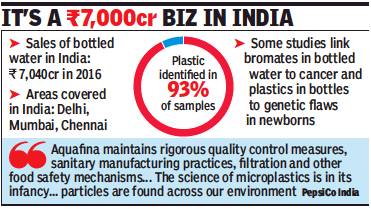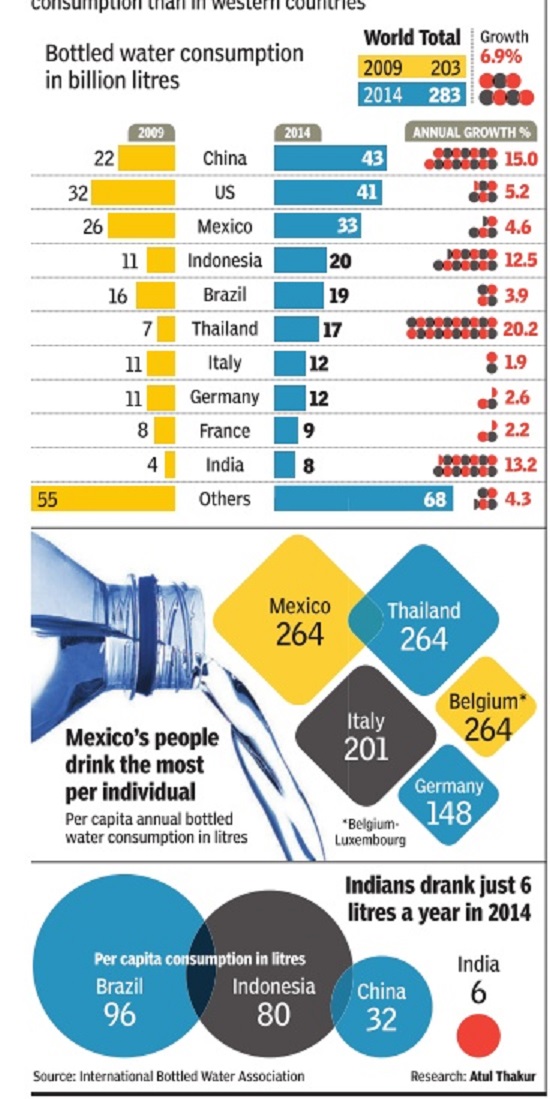Bottled water: India
This is a collection of articles archived for the excellence of their content. |
Contents |
The bottled water market in India
2009-2014: India 10th biggest market
CHINA CONSUMES FIVE TIMES MORE BOTTLED WATER THAN INDIA Sep 16 2016 : The Times of India (Delhi)
Bottled water is among the fastest growing packaged beverages across the globe, possibly linked to the belief that it is better than beverages with artificial sweeteners and energy drinks in avoiding obesity and other health risks. In terms of overall market, India is the world's tenth largest, though it has a much lower per capita consumption than in western countries
The quality of the water
2018 study by State University of New York
Study finds plastic pieces in 90% of bottled water, March 16, 2018: The Times of India

From: Study finds plastic pieces in 90% of bottled water, March 16, 2018: The Times of India
‘Contamination In Delhi, Mum, Chennai High’
A study by scientists from the State University of New York has found that more than 90% of bottled water worldwide, including India, contains tiny pieces of plastic. The researchers tested 259 individual bottles across 11 brands sold in nine countries, including Brazil, China, India, Indonesia and the US. Samples in India were drawn from 19 locations in Mumbai, Delhi and Chennai.
Top global brands, including Aquafina and Evian, as well as Indian brand Bisleri were tested. A Bisleri sample from Chennai showed over 5,000 microplastic particles per litre, according to data published by the researchers.
Although bottling companies insisted that they enforce strict quality control, findings indicating presence of carcinogenic substance in the water raise concerns about the long-term implications for public health. Polypropylene, used to make plastic bottle caps, was the most common polymeric material (54%) found in the samples while nylon was the second most abundant (16%).
After accounting for possible laboratory contamination, 93% of bottled water showed some presence of microplastics. Researchers found an average of 10.4 microplastic particles per litre of bottled water using spectroscopic analysis. This is twice as much as what was found in a previous study on tap water by the same team.
‘No contamination in just 17 of 259 bottles’
The data indicated the contamination is at least partially coming from the packaging or bottling process itself. Packaged drinking water is a loosely regulated industry in India with hundreds of big and small brands vying for a share of the metro and small-town market. Bottling units are regulated by state and central agencies in India, including the Bureau of Indian Standards and Food and Drug Administration (FDA). FDA officials were not available for comment on Thursday on the study despite repeated attempts.
The Indian Institute of Packaging is instrumental in checking water bottle samples for “quality of plastic and related contamination inside the bottle” on behalf of BIS. Officials with the IIP lab in Mumbai said preventive action is taken by BIS only if residual monomers, heavy metals or residual (chemical) catalysts are found beyond acceptable limits. However, such cases are rare, they said. Among leading companies, PepsiCo India contested the study’s findings, saying, “Aquafina maintains rigorous quality-control measures, sanitary manufacturing practices, filtration and other food safety mechanisms which yield a reliably safe product for enjoyment anywhere in the world. The science of microplastics and microfibres is in its infancy. Microplastic particles are found across our environment, including soil, air and water.”
The study mentions the batch number and location of purchase for all
the 27 lots of samples containing 259 bottles tested. Only 17 individual bottles “showed no microplastic contamination in excess of possible laboratory background”, said the study. The team said samples were sourced from a number of locations to increase the likelihood of diverse bottling sources.
Researchers found an average of 10.4 microplastic particles per litre of water. Densities of microplastic contamination varied from zero contamination to one bottle with an excess of 10,000 microplastic particles per litre.
